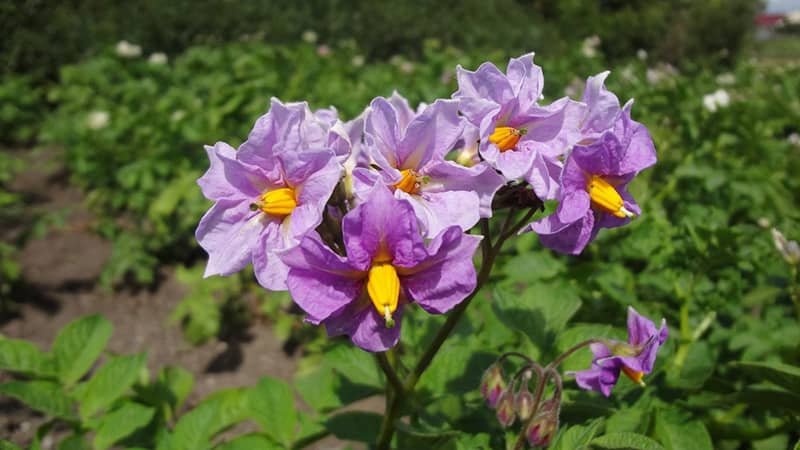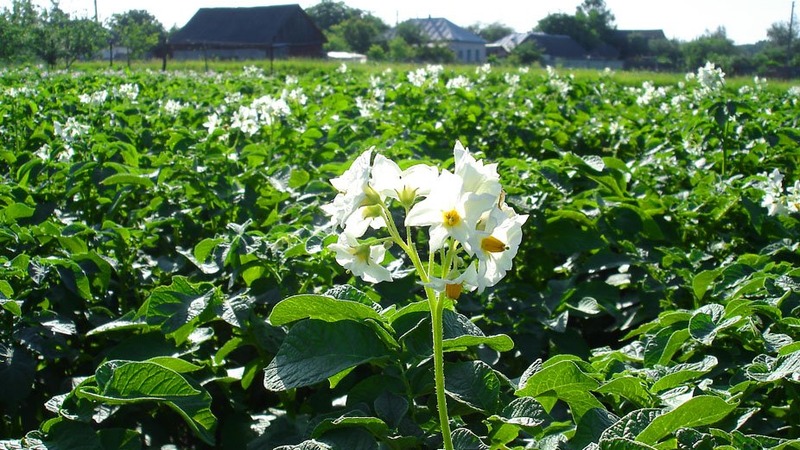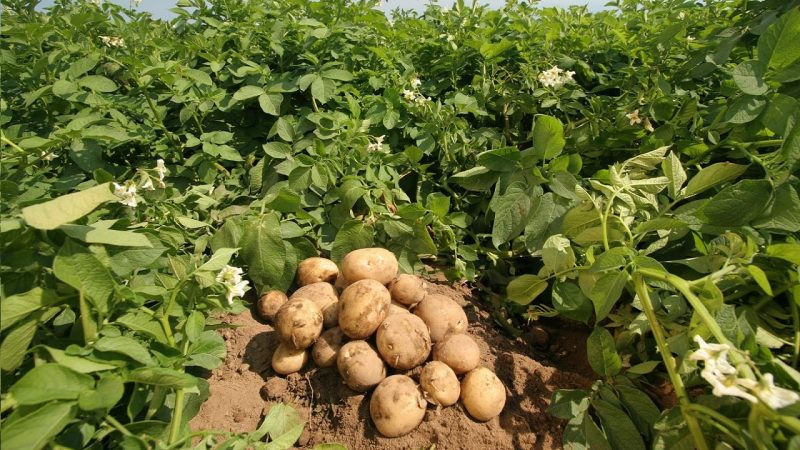What to do if potatoes do not bloom and why this happens
Potatoes are grown everywhere: they are unpretentious and productive crops, often resistant to adverse weather conditions. Some vegetable growers are faced with the fact that inflorescences do not form on the bushes. This is not only due to the damage to plants by diseases, pests or improper care, but also due to the characteristics of a particular variety. We will talk about this and other in more detail later.
The content of the article
When and how much potatoes bloom
The culture begins to bloom in about 25-30 days after germination. The size of tubers and their number depend on this important stage of the growing season. In the absence of flowering, the culture degenerates every year.
 On average, the cycle lasts two weeks, but in some varieties it goes faster. When budding and the beginning of flowering, plants form 20-30 small tubers, of which only 5-10 fully ripen. At their peak, vegetables store nutrients and water.
On average, the cycle lasts two weeks, but in some varieties it goes faster. When budding and the beginning of flowering, plants form 20-30 small tubers, of which only 5-10 fully ripen. At their peak, vegetables store nutrients and water.
Why potatoes don't bloom
There are several reasons why potatoes do not bloom: from varietal characteristics to non-compliance with agricultural cultivation techniques.
Features of the variety
Can potatoes not bloom? Some early varieties (Mariella, Rocco) form tubers even before the beginning of this growing season, others have small flowers and fall off quickly. Timo and the Empress are not genetically predisposed to flowering.
Important! The absence of this phase allows you to direct all the forces of the plant to the formation of tubers, protects against insect attacks.
Varieties Table 19, Early Rosa, Vyatka form buds depending on weather conditions and care.
Pests
Flowering is influenced by insectswho often carry various infections. The potato ladybug eats up the buds, foliage so that only veins remain, the bush dies.
Ground beetle quickly destroys leaves and flowers. Golden potato nematode does not allow shoots to develop normally, as a result the plants wither, flowering is absent or delayed.
Diseases
Wrinkled mosaic slows down the development of the culture, which leads to a lack of flowering, deformation of leaves and the completion of the growth of the green part of the bushes ahead of schedule.
Due to the pillar, the buds are formed incorrectly, the leaves turn yellow, the plants wither and die.
Violation of the conditions of planting and growing
When planted in a shaded area, inflorescences do not form due to lack of sunlight.
Sowing diseased or weakened tubers will lead to the fact that the potatoes not only do not bloom, but also do not yield a crop. Therefore, it is important to choose healthy planting material.
Important! Excess nitrogen in the area adversely affects flowering and tuber formation.
Insufficient care
During the period of budding and flowering, it is important to moisturize the culture: water carries the necessary nutrients. Water the plants 2 times a week, spending at least 3-4 liters of water per bush. At the same time, tubers suffocate in waterlogged soil.
In some cases, a long absence top dressing leads to the fact that the bushes slow down in development, do not form buds, tubers.
What to do if potatoes are not blooming

Having found out the cause of the problem, they begin to eliminate it. If a potato variety has been planted that does not bloom, or ripens quickly, do nothing. If plants are genetically predisposed to budding, pay attention to their appearance and growing conditions:
- Damaged leaves and buds, yellowed and wilted tops are signs of diseases and pests.Special preparations are used against them: from stolbur - "Fitoplasmin" and "Extrasol", from fungal diseases - "Metaxil", "Ordan", "Raek", "Talent", from insect pests - "Borey", "Sirocco", "Tanrek", "Sharpei". The funds are used according to the instructions.
- In hot and dry weather, the bushes shed their buds, preventing them from blooming. In this case, the planting is additionally moistened.
During the budding period, plants especially need feedingSince tubers are formed at this time, their taste and size depend on the incoming nutrients.
Fertilizer options (for 10 liters of water):
- 3 tbsp. l. ash, 1 tsp. potassium sulfate;
- 50 g of potassium sulfate;
- 30-40 g of urea;
- 10–20 g of ammonium nitrate;
- 2 g of copper sulfate, 10 g of potassium salt, 40 g of ammonium nitrate, 200 g of superphosphate.
This volume is spent on 1 hundred square meters of landings. Such dressings are useful even with the normal development of potato bushes.
Prevention measures

For planting, select healthy tubers without damage, rot and other defects. For prophylaxis, they are soaked for 2-3 hours in a disinfectant-nutrient solution (5 g of copper sulfate, 15 g of boric acid, 0.5 g of potassium permanganate per 10 l of water) or aerosol treatment is carried out.
To do this, mix 30 g of potassium sulfate, 40 g of carbamide, 15 g of boric acid, 1 g of copper sulfate, 0.5 g of potassium permanganate and 10 liters of water. The resulting solution is sprayed with planting material from a spray bottle. 1 liter is enough for 100 kg.
Important! Treatment from a spray bottle is carried out while there are no sprouts on the tubers. If available, the vegetables are first planted and then sprayed.
After the emergence of sprouts, pests and diseases are prevented:
- Weed thoroughly weeds on and around the site.
- Mint is planted next to potatoes, since many pests cannot tolerate its smell.
- The bushes are sprayed with infusions and decoctions from pests. To prepare a garlic infusion, 200-300 g of chopped garlic arrows or heads are soaked in 10 liters of water, infused for 2-3 days. To make a decoction of wormwood, 1 kg of grass is boiled in 2-3 liters of water for 15 minutes, filtered and diluted with 10 liters of pure water.
- The bushes are powdered with wood ash (3-5 kg per one hundred square meters).
Plants are fed with organic matter, since potatoes absorb nutrients quite quickly. Mix 0.5 l mullein, 1 tbsp. l. bird droppings, 1 tbsp. l. urea and 10 liters of water. Make 500 ml of the product per 1 bush.
To bring flowering closer, a mixture of 1 tbsp is added to the soil. wood ash, 1 tbsp. l. potassium sulfate and buckets of water.
Conclusion
The lack of flowers on a potato does not always mean that something is wrong with it. First of all, they look to see whether the variety is prone to flowering, whether the buds have not quickly fallen off. With the prevention of diseases and pests, adherence to the irrigation regime, optimal moistening of the plantings and the timely introduction of nutrients, potatoes will bloom and delight with a rich harvest.